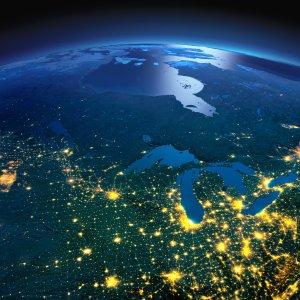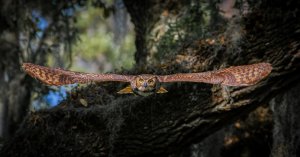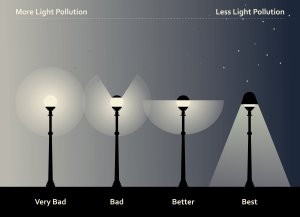Designed for Darkness in a World That Never Sleeps
October 2, 2024
By: Ali Groulx, Park Interpreter
The sky is a lavender hue with yellow and orange ribbons parallel to the horizon, as the glow of the sun fades, taking light along with it. As the world turns, we are no longer facing the sun, and the celestial beings reveal themselves; a powerful, spiritual moment respected with reverence. In the last century, this sight has become harder and harder to find, with the glow of human progress erasing one of our strongest instincts without us batting an eye. Bright streetlights have been erected to allow for activities around the clock, and just

when you think that you can go a couple miles out of the population center for some reprieve, you realize that the sky is still glowing from an industrial sized greenhouse or the city you were trying to escape. The full gravity of the consequences associated with sky glow, over-illumination, and unwanted light-trespassing is lost in a world dependent on artificial light. This not only affects our ability to see the stars, but animals’ ability as well, throwing them for a loop as they try to navigate without traditional star GPS. After all, we evolved under similar conditions, largely informing our worldview by using the stars for guidance. We also just happened to invent electricity and the light bulb.
Nighttime is a Habitat
Darkness is a crucial aspect of life for many animals. The light and dark cycles change with the seasons, informing critical life stages such as migration or hibernation. When artificial light bleeds into the sky, animal behaviors and schedules are changed. Nocturnal prey animals, like mice and voles, are less likely to venture out during the nighttime when there’s extra light. These animals may be worried that the illumination will reveal their presence to one of the most formidable night predators of all time, the owl. For millennia, owls have ruled the night, feasting on the creatures who had found solace in the darkness. To aid in their low-light delights, the entirety of the owl’s body is modified for their highly specific hunting tools. Large bony eye sockets hold their giant, light-sensitive, tube-shaped eyes in place. Offset cheek-ears allow them to pinpoint the faintest of sounds in the dark. Silent wings help them conduct precise sneak attacks, swooping down to snatch up their noisy

prey, crushing their spine with sharp taloned toes. With extra light, however, their highly specific hunting tools are rendered just as useful as a single-purpose kitchen gadget like a garlic press – mildly helpful, but mostly not the right tool for the job. Thankfully, there are things that we as humans can do to help our darkness-loving animal friends.
Problems? Solutions!
Light pollution is a recent development in our world. It’s not just one single light that’s the main culprit, either. The biggest issue is the collective light which produces something called sky glow, a dispersion of light into the atmosphere which affects humans and wildlife alike. More than 80% of the world’s population lives under sky glow, and artificial light at inappropriate times has implications within our body systems, disrupting our internal clocks and affecting our body’s production of sleep hormones like melatonin. Animals, like sea turtles, who depend on light coming from a certain location, are confused by big, bright city centers, often informing their choices by light from a source they cannot comprehend. Owls have a more difficult time staying undetected, as extra light can reveal their presence to their prey or their enemies. Even owls who have chosen to move back to hunting in the daytime, such as the snowy owl, depend heavily on celestial cues to

determine when it’s time to migrate. Alas, artificial light is a human-made problem, forcing us to find human-made solutions. Many streetlights are inefficient, and our outdoor lighting situations can be modified to reduce sky glow and unwanted light trespassing. The more we are aware of this issue, the more we can adjust our outdoor lighting to help make a difference for humans and animals in our own neighborhoods.
Owls as a Classic PR Representative
The humble owl has been used as a symbol for many initiatives and advertisements over the years. If you’re of a certain age, you may recall Woodsy Owl telling you to “give a hoot, don’t pollute,” or a Mister Owl trying to determine how many licks it takes to get to the center of a tootsie pop. As we improve our world for humans and animals alike, it is important to consider how light pollution affects one of the greatest nighttime predators to ever evolve. Maybe one day, there will be an owl mascot encouraging the reduction of light pollution!
By noticing what type of light we experience when it is meant to be dark out, we can make informed choices about our health and our living arrangements. There are many ways that we can still connect with the night sky, even in a world with light pollution. Plan a trip to one of Michigan’s dark sky parks to connect with the celestial beings up in the sky. If you would like to participate in a Metropark’s astronomy event, check out our astronomy events page! And lastly, keep an eye on our events calendar for fall opportunities to participate in an Owl Prowl for the chance to hear or see an owl after dark.
